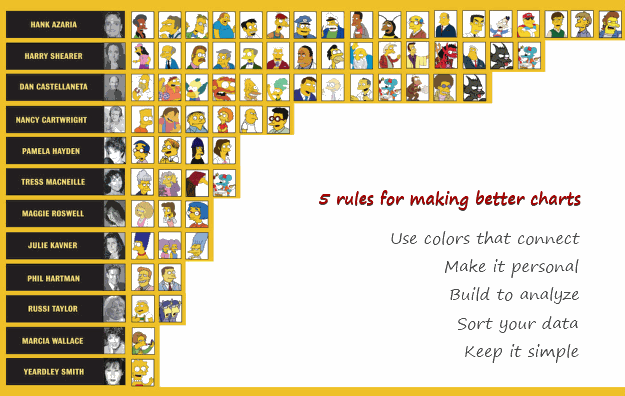Jeff Weir, an alert reader of our blog points me this chart showcasing voice-over artist’s for various Simpson’s characters. I am a hard-core Simpon’s fan, so I naturally wasted 10 minutes looking at the chart. That is when I realize this chart is not only fun, it also teaches 5 valuable lessons on making better charts.
One fun chart

[view high res | original credit]
5 Rules for Making Better Charts
- Make it personal: I immediately looked up my favorite characters when I saw this chart. I am sure that is what many of you would do too. Charts / Slides that poke curiosity thru personal connections are memorable.
- Keep it simple: I am sure one of the new social media info-graphics wiz-bang would have made a whole poster out of this little data, but not this chart maker. Whoever made this chart chose a simple medium (bar chart) to show the characters and voice-over artists. And it works. Whenever you are tempted to use a complex chart, think for a minute if a simpler, familiar alternative is available and use it. KISS always works.
- Sort it: The chart is sorted by number of characters by artist. Sorting makes it easy to compare and view. You should always consider sorting your data in meaningful order.
- Use colors that connect: This chart uses bright yellow color, almost the same as the skin color of Simpson’s characters. It connects well with the audience. You should try to use colors that evoke emotional responses from your audience, whenever possible.(tip: using color in charts)
- Make it easy to compare: One comparison you can immediately draw is that male artists (Hank, Harry, Dan etc.) do so much more voice over work than female artists (Nancy, Yeardley, Julie etc.). You can tell this because the photos of artists are also available next to their names. Remember, your audience are looking for patterns, hidden messages in your charts. So make your charts with that in mind.
Question: What rules do you recommend for making better charts?
Go ahead and tell us what rules do you think we should follow to make awesome charts using comments.
Bonus Question: Who is your favorite non-Simpson Simpson’s character?
I don’t think about charting and formulas too much when weekend is around the corner, and neither should you. So go ahead and indulge in harmless banter. Tell me which non-Simpson Simpson’s character is your favorite?
For me Ned Flanders does it. I think his dialogues are very cleverly written. What about you?




















One Response to “How to export YouTube video comments to Excel file? – Free template + Power Query case study”
And I asked myself when i saw your Accouncement Video for the Give away: "Seriously, will Chandoo go manualy thru all his Videos and pick the winners?!". Great connection to the give away with this tutorial 🙂 !